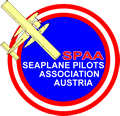 Flying With Floats is a Transport Canada
publication for seaplane pilots. Only the textual content of the
publication is presented here. It is available in hard copy from
Transport Canada, AABA, Aviation Safety Programs, Place de Ville,
Ottawa Ontario, K1A 0N8
Flying With Floats is a Transport Canada
publication for seaplane pilots. Only the textual content of the
publication is presented here. It is available in hard copy from
Transport Canada, AABA, Aviation Safety Programs, Place de Ville,
Ottawa Ontario, K1A 0N8
FLYING WITH FLOATS (TP 5584e)
Preparing yourself
- Think of yourself as a sailor and a flyer.
- Know survival techniques including the
hazards of hypothermia.
- Know your aircraft - be trained on type
and current.
Preparing the aircraft
- Fuel - clean and sufficient.
- Pump floats - note leaks - repair.
- Life jackets.
- Refuelling hand pump, filters and fuses,
paddle, float pump.
- Survival gear (don't forget insect
repellent).
- A couple of 50' x 1/2" wing lines and 30'
throw line.
- Red lined prop arc on floats - danger
placard inside doors.
Flight planning
- Make your intentions known (AIP RAC 3.0).
- Check the weather all along the route by
whatever means available (AIP MET).
- Float flying is day VFR flying.
- Have an alternate - avoid pressing the
weather and darkness.
- Leave yourself an out.
Preparing for flight
- Preflight done - complete all the
checklist items.
- load secure and within limits.
- Carry only approved external loads and
remember the wake turbulence -- avoid blanking your tail
feathers!
Departure
- Passenger briefing - include the location
and use of life jacket, seat belt and door releases - very
important in the event of an upset.
- Note wind and currents; plan engine
start, cast off and take off before leaving the dock.
- Know your takeoff distance requirements.
- Check for other aircraft, boats,
deadheads, and other floating debris.
- When taxiing, don't bury the outside
float in the upwind turn - allowing the aircraft to weathercock
is the safest way.
- Don't take off across the entrances to
small bays or coves - boats may suddenly appear.
- Know the marine rules (AIP AIR 5.0).
En route
- On track, on time - getting lost in
remote areas is easy - skillful map reading is a must.
- Be weather wise.
- Watch for other traffic and suitable
forced landing areas.
- Always leave yourself an out!
Arrival
- Overfly water landing area to assess wind
strength and direction.
- Check landing run area for floating
obstacles, submerged deadheads and boaters.
- Check approach for obstructions - trees,
buildings and wires.
- Wires usually run between islands and
mainland.
- Check the departure area for obstructions
and remember that landing distance doesn't guarantee adequate
takeoff distance.
- Know your glassy water procedures.
- Observe wind, current and other aircraft
at the docking area.
- Brief passengers on unloading procedure,
particularly the "propstrike" threat.
- Be wary of "helpful" individuals on board
and ashore.
Top 10 occurances
- Engine failure/malfunction -
usually from fuel mismanagement.
- Loss of control in flight/mush/stall
- by selecting an unsuitable takeoff or landing area, improper
loading and overloading.
- Dragged wing/float/pod - because
of unfavourable wind or water conditions.
- Nose over - glassy water and too
flat a hold-off attitude contribute to this one.
- Loss of control ground/water - due
to rough water and crosswinds.
- Hard landings - caused by an
improper landing flare, crosswind or glassy water.
- Collision - with deadheads or
other obstacles during takeoff or landing.
- Overrun - due to excessive
airspeed and not enough landing area.
- Wheels down on water - this occurs
with amphibious aircraft - where's the checklist!
- Injuries - prop contact - usually
due to inattentive passenger handling - improper briefings..
All of these relate directly to the pilot and most happen during
takeoff and landing.
Learn from the mistakes of others. Asking for advice doesn't show
your ignorance. Not asking does!
Pattern for survival
- Protection
- First aid
- Signals
- Comfort
|
 SPAA
SPAA  SPAA
SPAA